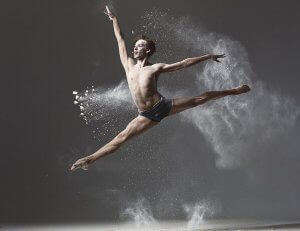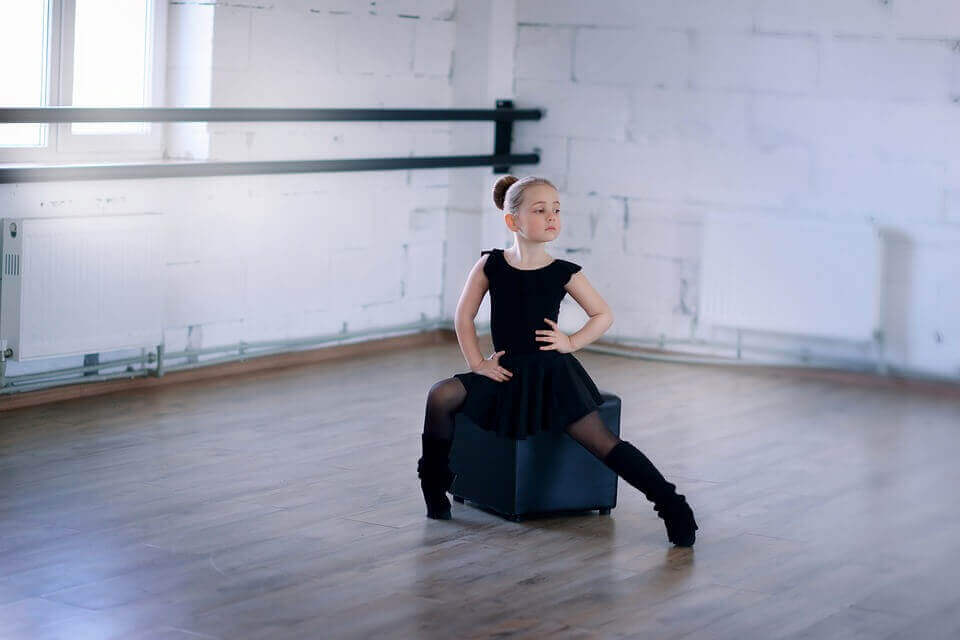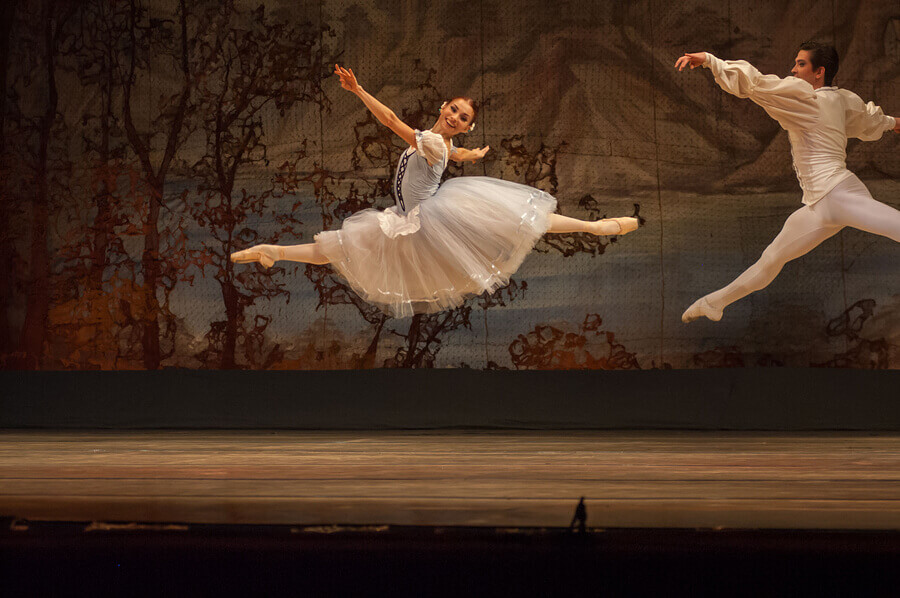The Extraordinary Skill Set of Ballet Dancers

Ballet dancers develop their physical skill set to extraordinary lengths throughout their career. In order to have a better understanding of what they can actually do, we want to dedicate our post today to their amazing capabilities.
Classical ballet originates from around 1600, during the reign of Louis XIV. Back then, ballet was a form of pantomime with music and dance. Ballet celebrated religious fertility, war and other types of ceremonies.
Over time, ballet came closer to perfection through the efforts of teachers and choreographers until finally an actual method was created in Russia. Today, many ballet schools follow that same method.
Agrippina Vaganova made a big contribution to ballet history by creating a pedagogical system and technique that focused on developing flexibility, strength, posture and agility— not to mention the other characteristics of classical ballet.
Ballet is an art form that combines physical activity, emotions, theater and music. To add on, ballet dancers are also capable of pushing their minds and bodies much further than the average person.
The incredible skill set of ballet dancers
1. Foot strength and resistance
Ballet dancers follow exercises that strengthen their feet tremendously. For example, they can stretch their feet, maintaining their weight on their toes.
The exercises they do in class will strengthen their limbs to the point where they can sustain their entire body weight on their feet, or even on just one foot. They also work on their instep, which allows women to achieve more stability when dancing on pointe.
The resistance also helps them withstand blisters and scrapes that come along with certain dance movements. This is especially true for ballerinas as they use pointe shoes that keep them on their tiptoes. It’s painful, bloody and leads to many blisters and bruises.

2. Flexibility
Ballet dancers can bend their bodies in many ways. Flexibility is a major factor in this sport.
For example, dancers learn how to touch their heads with their feet. Or, they learn the splits and some, oversplits. Oversplits consist of pushing past the normal range of movements in joints and tendons.
3. Turning without losing focus
Turning many times in a single direction isn’t easy. If you try it yourself, you can lose balance and become dizzy. But imagine spinning on tiptoe or on just one leg with the other lifted. If that’s not enough, try timing yourself to the music as well.
Ballet dancers can spin repetitively by using an impeccable technique, and they make it look easy. They keep their eyes fixed on one spot, which allows them to spin quickly without losing balance.
4. Pain tolerance is second to none
Pointe shoes, heel friction or the steep point off the floor, tight muscles after long hours of practice and other injuries (small and serious) give ballet dancers an extremely high pain tolerance.
Dancers can ignore the pain and continue dancing; however, it can lead to serious consequences. But many do so in order to chase big career opportunities. Injuries are a constant reality in dance so in a way, they have to get used to them.
5. Strength and impulse
Ballet is delicate and elegant. But the dancers have incredible strength and impulse. Consider this: they use their body to lift others in different styles. In fact, a male ballet dancer can carry many ballerinas in just one show without any real difficulty.
Furthermore, male ballet dancers have incredible strength in their legs and core, which allows them to jump as high as soccer players do. The only difference is that dancers jump with grace.

6. Body control, the seal of a ballet dancer
The exercises that ballet dancers do in classes help improve their psychomotor abilities. Thus, they improve in agility, coordination and spatial perception to do all kinds of movements.
In addition, dancers possess incredible control over their bodies; they can contract certain muscles while relaxing others. They can also move a single part of their bodies in all kinds of ways.
Classical ballet is extremely demanding in both a physical and mental sense. However, all of that hard work translates into a work of art that only requires a human body to express a masterpiece.
Ballet dancers are undoubtedly determined individuals that push the normal limits of the human body. In addition, they aim to move hearts with diverse stories and interpretations with an artistic vision without equal.
Ballet dancers develop their physical skill set to extraordinary lengths throughout their career. In order to have a better understanding of what they can actually do, we want to dedicate our post today to their amazing capabilities.
Classical ballet originates from around 1600, during the reign of Louis XIV. Back then, ballet was a form of pantomime with music and dance. Ballet celebrated religious fertility, war and other types of ceremonies.
Over time, ballet came closer to perfection through the efforts of teachers and choreographers until finally an actual method was created in Russia. Today, many ballet schools follow that same method.
Agrippina Vaganova made a big contribution to ballet history by creating a pedagogical system and technique that focused on developing flexibility, strength, posture and agility— not to mention the other characteristics of classical ballet.
Ballet is an art form that combines physical activity, emotions, theater and music. To add on, ballet dancers are also capable of pushing their minds and bodies much further than the average person.
The incredible skill set of ballet dancers
1. Foot strength and resistance
Ballet dancers follow exercises that strengthen their feet tremendously. For example, they can stretch their feet, maintaining their weight on their toes.
The exercises they do in class will strengthen their limbs to the point where they can sustain their entire body weight on their feet, or even on just one foot. They also work on their instep, which allows women to achieve more stability when dancing on pointe.
The resistance also helps them withstand blisters and scrapes that come along with certain dance movements. This is especially true for ballerinas as they use pointe shoes that keep them on their tiptoes. It’s painful, bloody and leads to many blisters and bruises.

2. Flexibility
Ballet dancers can bend their bodies in many ways. Flexibility is a major factor in this sport.
For example, dancers learn how to touch their heads with their feet. Or, they learn the splits and some, oversplits. Oversplits consist of pushing past the normal range of movements in joints and tendons.
3. Turning without losing focus
Turning many times in a single direction isn’t easy. If you try it yourself, you can lose balance and become dizzy. But imagine spinning on tiptoe or on just one leg with the other lifted. If that’s not enough, try timing yourself to the music as well.
Ballet dancers can spin repetitively by using an impeccable technique, and they make it look easy. They keep their eyes fixed on one spot, which allows them to spin quickly without losing balance.
4. Pain tolerance is second to none
Pointe shoes, heel friction or the steep point off the floor, tight muscles after long hours of practice and other injuries (small and serious) give ballet dancers an extremely high pain tolerance.
Dancers can ignore the pain and continue dancing; however, it can lead to serious consequences. But many do so in order to chase big career opportunities. Injuries are a constant reality in dance so in a way, they have to get used to them.
5. Strength and impulse
Ballet is delicate and elegant. But the dancers have incredible strength and impulse. Consider this: they use their body to lift others in different styles. In fact, a male ballet dancer can carry many ballerinas in just one show without any real difficulty.
Furthermore, male ballet dancers have incredible strength in their legs and core, which allows them to jump as high as soccer players do. The only difference is that dancers jump with grace.

6. Body control, the seal of a ballet dancer
The exercises that ballet dancers do in classes help improve their psychomotor abilities. Thus, they improve in agility, coordination and spatial perception to do all kinds of movements.
In addition, dancers possess incredible control over their bodies; they can contract certain muscles while relaxing others. They can also move a single part of their bodies in all kinds of ways.
Classical ballet is extremely demanding in both a physical and mental sense. However, all of that hard work translates into a work of art that only requires a human body to express a masterpiece.
Ballet dancers are undoubtedly determined individuals that push the normal limits of the human body. In addition, they aim to move hearts with diverse stories and interpretations with an artistic vision without equal.
All cited sources were thoroughly reviewed by our team to ensure their quality, reliability, currency, and validity. The bibliography of this article was considered reliable and of academic or scientific accuracy.
- Twitchett, E. A., Koutedakis, Y., & Wyon, M. A. (2009). Physiological fitness and professional classical ballet performance: a brief review. Journal of Strength and Conditioning Research / National Strength & Conditioning Association. https://doi.org/10.1519/JSC.0b013e3181bc1749
- van Vugt, M. K. (2014). Ballet as a movement-based contemplative practice? Implications for neuroscientific studies. Frontiers in Human Neuroscience, 8. https://doi.org/10.3389/fnhum.2014.00513
- Guss-West, C., & Wulf, G. (2016). Attentional Focus in Classical Ballet: A Survey Of Professional Dancers. Journal of Dance Medicine & Science, 20(1), 23–29. https://doi.org/10.12678/1089-313x.20.1.23
- Twitchett, E., Angioi, M., Koutedakis, Y., & Wyon, M. (2010). The demands of a working day among female professional ballet dancers. Journal of Dance Medicine & Science : Official Publication of the International Association for Dance Medicine & Science, 14(4), 127–32. Retrieved from http://www.ncbi.nlm.nih.gov/pubmed/21703083
- Harris-Warrick, R. (2009). Ballet. In The Cambridge Companion to Eighteenth-Century Opera (pp. 99–111). Cambridge University Press. https://doi.org/10.1017/CCOL9780521873581.007
This text is provided for informational purposes only and does not replace consultation with a professional. If in doubt, consult your specialist.








